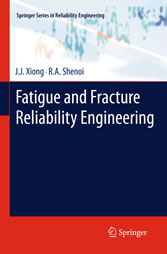Suchen und Finden
Preface
5
Contents
10
Deterministic Theorem on Fatigue and Fracture
13
1.1 Introduction
13
1.2 Fatigue Failure Character and Fracture Analysis
14
1.3 Cyclic Stress and S–N Curve
16
1.4 Constant Life Curve and Generalized Fatigue S–N Surface
19
1.5 Stress State and Growth Mode of Penetrated Crack
22
1.6 Crack Growth Rate and Generalized Fracture S– N Surface
30
1.7 Total Life Prediction
36
References
37
Reliability and Confidence Levels of Fatigue Life
39
2.1 Introduction
39
2.2 Basic Concepts in Fatigue Statistics
40
2.3 Probability Distribution of Fatigue Life
49
2.4 Point Estimation of Population Parameter
59
2.5 Interval Estimation of Population Mean and Standard Deviation
62
2.6 Interval Estimation of Population Percentile
68
References
73
Principles Underpinning Reliability based Prediction of Fatigue and Fracture Behaviours
74
3.1 Introduction
74
3.2 A Randomized Approach to a Deterministic Equation
75
3.3 Single-Point Likelihood Method
86
3.4 Generalized Constant Life Curve and Two-Dimensional Probability Distribution of Generalized Strength
90
3.5 Full-range S–N Curve and Crack Growth Rate Curve with Four Parameters
101
3.6 Reliability Determination of Fatigue Behaviour Based on Incomplete Data
108
References
113
Data Treatment and Generation of Fatigue Load Spectrum
115
4.1 Introduction
115
4.2 Rain Flow-Loop Line Scheme
117
4.3 Two-Dimensional Probability Distribution of Fatigue Load
124
4.4 Quantification Criteria to Identify Load Cycle
126
4.5 Equivalent Damage Formulations
131
4.6 Experimental Verification
133
4.7 Application in Full-Scale Fatigue Test of Helicopter Tail
139
References
142
Reliability Design and Assessment for Total Structural Life
144
5.1 Introduction
144
5.2 Probability Method for Infinite Life Design
145
5.3 A Generalised Interference Model
147
5.4 Fracture Interference Model
149
5.5 Reduction Factor
150
5.6 Scatter Factor
153
5.7 Durability Model to Assess Economic Structural Life
157
References
164
Reliability Prediction for Fatigue Damage and Residual Life in Composites
166
6.1 Introduction
166
6.2 Two-Stage Theory on Composite Fatigue Damage
168
6.3 Fatigue-Driven Residual Strength Model based on Controlling Fatigue Stress
170
6.4 Fatigue-Driven Residual Strength Model based on Controlling Fatigue Strain
178
6.5 Constitutive Relations for Composite Damage
187
6.6 Stress Concentration of Notched Anisotropic Laminate
193
6.7 Composite Damage Evolution Equation and Generalized r– N Surface
196
References
198
Chaotic Fatigue
200
7.1 Introduction
200
7.2 Nonlinear Differential Kinetic Model of Atomic Motion at Crack Tip
202
7.3 Hopf Bifurcation of Atomic Motion at Crack Tip
207
7.4 Global Bifurcation of Atomic Motion at Crack Tip
211
7.5 Stochastic Bifurcation of Atomic Motion at Crack Tip
213
7.6 Solution of Fatigue Damage FPK ( Fokker- Planc- Kolgmorov) Equation
216
7.7 Damage Probability Distributions for Fatigue Crack Formation and Propagation
218
References
222
Alle Preise verstehen sich inklusive der gesetzlichen MwSt.




















